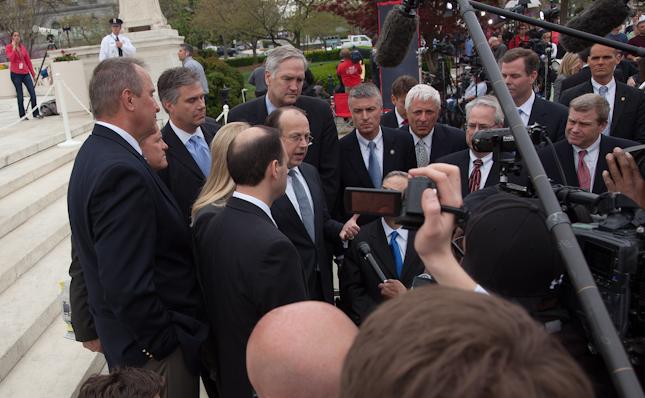Amidst the Obamacare Debate: Inside and Outside the Supreme Court
By • April 5, 2012 0 660

Inside, in that majestic, bone-white building, men and women in robes and the best lawyers in the United States were in the midst of a historic debate on the merits, demerits and future of President Barack Obama’s historic health care proposal, passed by Congress two years ago.
Outside near the steps, the masses—many of them highly vocal members of the Tea Party—had gathered to conduct their own debates, large and small, a quartet here, two people finger pointing there, some being interviewed by the gathered media come to this place like bees to flowers.
From the written and televised reports of the three-day review and legal discussions—an unprecedented effort for a piece of major legislation being considered by the Supreme Court—Obama’s health care plan was not faring well, especially the controversial mandate which purports that everyone must buy health insurance or be penalized. And so, Chief Justice John G. Roberts Jr., and Justices Antonin Scalia, Anthony M. Kennedy, Clarence Thomas, Ruth Bader Ginsburg, Stephen G. Breyer, Samuel A. Alito, Jr., Sonia Sotomayor and Elena Kagan dug in, listened and asked questions and made comments which were studied like runes by the media and opponents and proponents of the health care plan.
Outside were people like Lenny and Dave, who argued vehemently on a first-name basis, and other loud or muted voices weighing in. But by the steps, and certainly at a nearby rally of conservative opponents, which included speeches by Republican Congressman Paul Ryan, who talked about budget cuts, debt and freedom, it was clear that the anti’s outnumbered the bill’s supporters.
Tuesday, and no doubt Wednesday, and for sure Monday, was an ongoing replay of the nation’s great divide over the issue, a divide which had all but given birth to the tea party and resulted in the Democratic Party’s loss of the House of Representatives.
Nothing had changed: Tea Party demonstrators pretty much talked and behaved as you might have expected. They argued with some remnants of the occupiers which were still in Washington, they boiled down the health care bill to its mandate provision and, like the GOP presidential candidate Rick Santorum, rolled up into a one-word cause: freedom.
No such simplicities were evidenced at the Supreme Court case where judges at worst tried to critique the mandate as being the same as being forced to buy food that’s good for you. But everyone inside acknowledged that the bill was much too complicated, big and long, to fully be understood in all of its details.
That did not deter the debates outside, where everything squeezed itself into slogans (OMG-Obamacare-Must-Go) or the classic liberal/conservatives divides and a growing sense of utter frustration and unreasonableness. Two men were arguing about the debt, about the bill, about the growth of government. “I don’t care, Dave,” a man holding up a “don’t touch my health care” sign said, gesturing with his hands. “I don’t know what Reagan did, I don’t care if he did, or what the deficit was then, you’re still wrong. Understand that you’re completely wrong.”
You could see another woman arguing with a young black man, re-interpreting the Civil War and its causes by suggesting that slavery had little if anything to do with it. “The North wanted the South’s money, that’s what it was,” she said. “They had a contract, and they chose to leave it.”
If you’re of a conciliatory, negotiating mind and have your own opinions about health care and the mandate, the tea party folks are a tough sell. To them, it’s all about freedo and big government and how it infringes on said freedoms. And if that argument fails by itself, well, you know, they have a direct pipeline to the hearts and minds of the founding fathers and what they intended. Obviously, they have not seen “1776.”
At the rally, the crowd seemed to sense a wavering of support for what has now been embraced by both sides as Obamacare. The green “Don’t Tread On Me” signs and the “Don’t touch my health care” signs stuck out, as did a sign portraying Obama as the last in a long line of prominent Socialists like Mao Tse Tung, Stalin and Lenin and Marx. Meanwhile, one of the surviving Socialists was at that time having a chat with the Pope in Cuba.
It’s hard to stay out of the talk and just listen to it. The Tea Party is not made up of strangers—they look exactly like many of the out of work teachers and civil servants who came here for the first big rally of the Occupy DC movement. They look like the ruddy salt of the earth, with bills to pay and children to raise (one man was holding a sleeping baby, and pushing a double-baby carriage). The difference is that these people exercising their rights to freely argue and say any preposterous things that come to mind are difficult to talk with on any issue at hand—not because they’re right, but because they’re angry and afraid. They’re angry—like the rest of us—about just about everything, and afraid of the government. Often, their ideas about the government of the United States resembles something that was dropped on us from outer space, intent on controlling every aspect of our lives, and that the president—especially this president—is an alien stranger, and certainly not a real American.
It’s likely that inside the court, the conversation was more muted, and the hope exists among reasonable folks that the three-day talks and the subsequent deliberations will produce a reasonable outcome that’s not purely political. The hope now appears slim: it should be remembered that this court by a 5-4 margin produced a ruling that has resulted in the proliferation of Super Pacs in the 2012 election, a result that’s had a huge effect on the political landscape.
Click Here to View Jeff Malet’s photo Coverage the Supreme Court hearings

